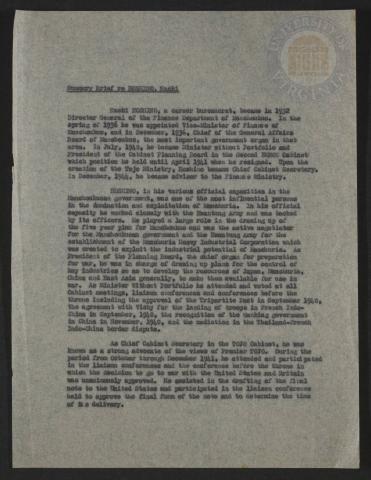
Page 1
| Parent | Summary Brief about Naoki Hoshino |
|---|---|
| Date | |
| Language | English |
| Collection | Roy L. Morgan Papers |
| Box | Box 3 |
| Folder | 1946 [IMFTE] (IPS) Translations of interrogations. |
| Repository | University of Virginia Law Library |
Summary Brief re HOSHINO, Naoki
Naoki HOSHINO, a career bureaucrat, became in 1932 Director General of the Finance Department of Manchukuo. In the spring of 1936 he was appointed Vice-Minister of Finance of Manchukuo, and in December, 1936, Chief of the General Affairs Board of Manchukuo, the most important government organ in that area. In July, 1940, he became Minister without Portfolio and President of the Cabinet Planning Board in the Second KONOE Cabinet which position he held until April 1941 when he resigned. Upon the creation of the Tojo Ministry, Hoshino became Chief Cabinet Secretary. In December, 1944, he became advisor to the Finance Ministry.
HOSHINO, in his various official capacities in the Manchukuo government, was one of the most influential persons in the domination and exploitation of Manchuria. In is official capacity he worked closely with the Kwantung Army and was backed by its officers. He played a large role in eh drawing up of the five year plan for Manchukuo and was the active negotiator for the Manchukuo government and the Kwantung Army for the establishment of the Manchuria Heavy Industrial Corporation which was created to exploit the industrial potential of Manchuria. As President of the Planning Board, the chief organ for preparation for war, he was in charge of drawing up plans for the control of key industries so as to develop the resources of Japan, Manchuria, China and East Asia generally, to make them available for use in war. As Minister Without Portfolio he attended and voted as all Cabinet meetings, liaison conferences and conferences before the throne including the approval of the Tripartite Pact in September 1940, the agreement with Vichy for the landing of troops in French Indo-China in September, 1940, the recognition of the Nanking government in China in November, 1940, and the mediation in the Thailand-French Indo-China border dispute.
As Chief Cabinet Secretary in the TOJO Cabinet, he was known as a strong advocate of the views of Premier TOJO. During the period from October through December 1941, he attended and participated in the liaison conferences and the conference before the throne in which the decision to go to war with the United States and Britain was unanimously approved. He assisted in the drafting of the final note to the United States and participated in the liaison conference held to approve the final form of the note and to determine the time of its delivery.
